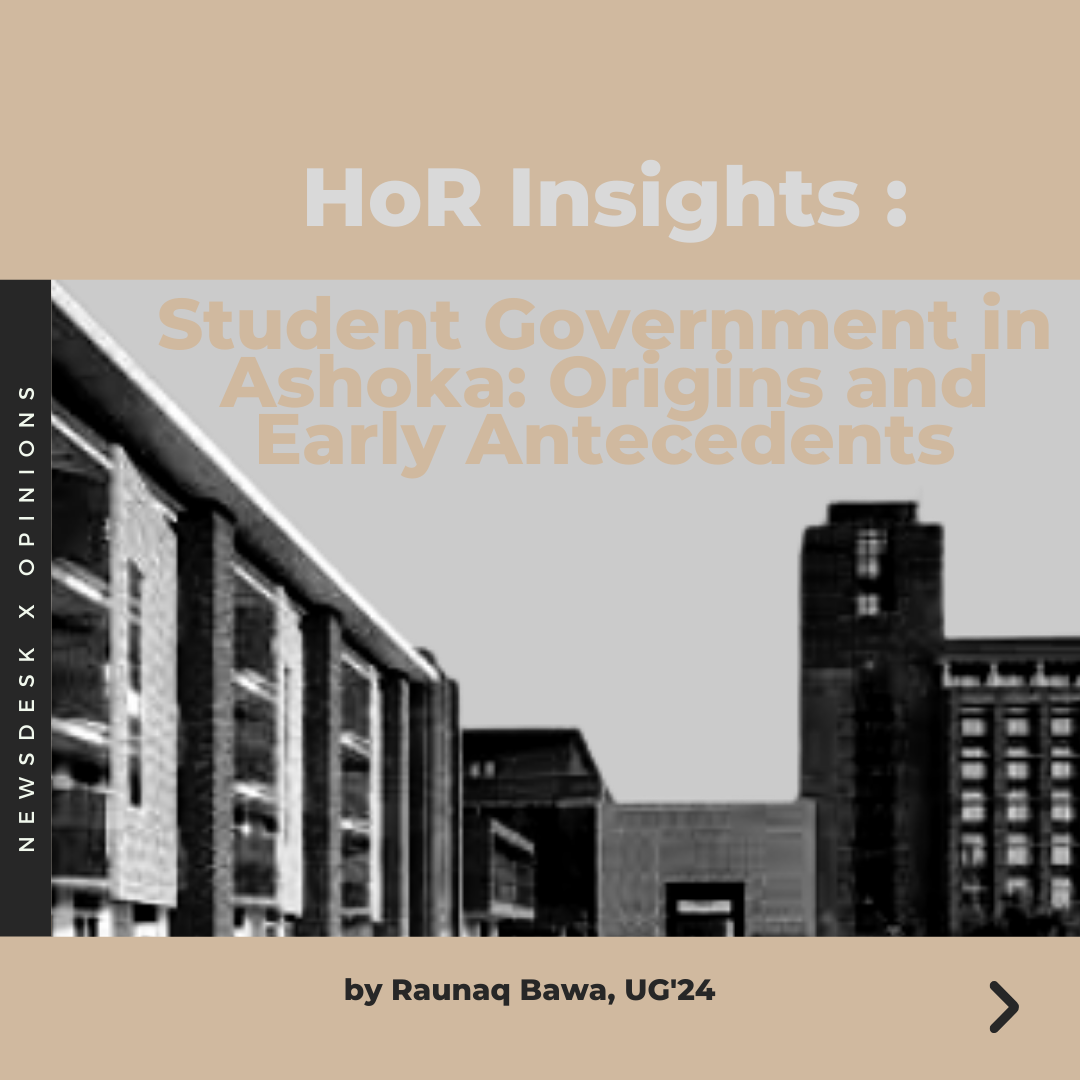
Student Government in Ashoka: Origins and Early Antecedents
Part 1: Origins, Reform, and Early Functioning
- by Raunaq Bawa, UG’24
Following the prologue on the Modified Swiss-PR System and whether it is best suited for Ashokan politics, our series HoR Insights focuses on the earliest days of Ashoka University’s Student Government and House of Representatives. This article is a two-part deconstruction of the formation of Ashoka University’s Student Government and House of Representatives. In conversation with Sanat Sogani (the second President of the AU House of Representatives) and KC Sachin (third President of the House), this brief narrative serves to provide readers an insight into the formation of these institutions and the driving vision behind their creation, and to draw contrasts between the past and the present of student politics at Ashoka.
In 2015, barely a year after Ashoka University opened its doors to its first batch of undergraduate students, the Constitution of its Student Government was unveiled in a public ceremony. This would mark the beginning of the era of student politics at Ashoka University, which would go through its many ups and downs over the following years.
Amongst the first batch of the University, a growing demand for a formal institution to represent student interests had caught the attention of the administration, which lent its support to the creation of the proposed Student Government (SG). KC Sachin, the third president of the Student Government, explained that the driving vision behind this endeavour was to have an institution that would “have the students’ backs” and would ensure that the students’ voice was heard in how the University was being run. Ashoka itself being in its infancy at the time, the institution of the SG would allow the students to work together with the founders and administration in the process of building up the university, as equal stakeholders.
Sanat Sogani, formerly second president of the House of Representatives, credited Professor Gilles Verniers for his assistance in the endeavour of setting up the SG. The students who wished to set up this SG endeavoured for a credible institution which would represent legitimate student interests, instead of devolving into a system encouraging ‘popularity contests’ in the name of electoral democracy. A system of political parties — not affiliated with national political parties, unlike what happens in most public universities in India — would generate political discourse and electoral competition within this system. To set down on paper this envisioned democratic system, a Constituent Assembly was established.
This Assembly, established with the ratification of the Vice Chancellor and the Pro-Vice Chancellor, was a fifteen-member student body, which laboured for six months to draft a Constitution for the proposed SG. This Constitution would be inspired by similar documents governing student governments and unions in other Universities, as well as by the Constitution of India.
Initial political engagement among the student body, both Sachin and Sanat agree, was encouraging—both in terms of voter turnout and political mobilisation of parties and candidates. Student political parties took an active part in the Constituent Assembly and in the subsequent Houses, with Dhamma, Prakrit, and United Ashoka being the principal parties of the time. Sanat pointed out the lack of ideological diversity amongst Ashokan political parties (one may argue this is the case at present as well), with their main differences being in the issues being prioritised.
In this context, the first House was formed in 2015, with Ajay Sabarwal, a former member of the Constituent Assembly, leading it as the founding President. Sanat Sogani acted in the capacity of first Prime Minister of the House. Both Sachin and Sanat described the First House as being a tumultuous one. This was attributed to the two-heads system, which accorded powerful leadership roles to both the President and Prime Minister, resulting in deadlocks and clashes. This caused the House to become inefficient in carrying out its duties. Not only did this lower the House in the estimation of the student body, it also led to the resignation of four members—not a good sign for its first year.
Thus in the second year, with Sanat’s election to the post of President, the Prime Ministerial post was abolished, and the reigning system of the President as the sole head was established. With this, the SG and House now got to work. Sachin credits to the Second House the important achievement of entrenching and strengthening its various decision-making structures and procedures. With rising student participation in the House’s functioning, many House committees were constituted and enjoyed active student involvement. The issue of workers’ rights was also seriously taken up during this time.
While wages were never the primary issue of contention, job security was a significant problem for workers, especially in light of the external vendor system. This system acted as a third party in hiring workers and having a say in their affairs (a system that persists today). With significant lobbying by the SG, the administration made several concessions for this issue — the constitution of the Workers’ Welfare Committee, setting up a special grievance redressal cell, the provision of special helplines for workers to call on, and the proliferation of posters across campus in vernacular languages for the benefit of the workers. Further, the SG also lobbied for changes in campus rules that were deemed as inequitable and discriminatory. For instance, it successfully pushed for the abolition of a prohibition against workers sharing meal spaces with students. However, Sanat and Sachin also acknowledged the shortcomings of these efforts — on top of general awareness of workers’ rights remaining low, facilities such as the helpline also did not seem to yield significant dividends for the cause.
This concludes the first of this two-part series. The second part continues the saga of the Second House and moves on to cover the tenure of the Third House.
